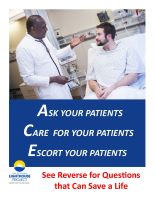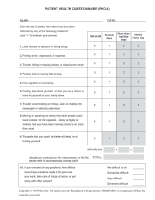Introduction and Overview
The following resources are available to help providers screen and assess, design treatment protocol, prescribe medication and provide referrals for children and adolescents at risk for suicide.
Screening & Assessment
 Columbia-Suicide Severity Rating Scale (C-SSRS)
Columbia-Suicide Severity Rating Scale (C-SSRS)
The C-SSRS is designed for professionals to assess suicide risk, with several versions tailored to varied settings or populations.
 National Institute of Mental Health Ask Suicide-Screening Tool (ASQ)
National Institute of Mental Health Ask Suicide-Screening Tool (ASQ)
The ASQ is a suicide screening tool for use among both youth and adults. All toolkit materials are available on the NIMH website.
Popular patient depression questionnaire. Modified for Adolescents (PHQ-A), Modified for Teens.
Is designed to screen for non-negligible risk and provide initial stratification for those with non-negligible risk into mild, moderate, or high risk.
Treatment
There are two proven types of psychotherapies Cognitive Behavior Therapy(CBT) and Dialectical Behavior Therapy(DBT)
Referral and Co-Management
N/A for this topic
Medication
Clozapine is the only FDA approved medication for suicidal risk reduction
Billing/Coding
N/A for this topic
Additional Resources
Websites
National Institute of Mental Health: The lead federal agency for research on mental disorders.
Teen Suicides: What are the Risk Factors? Child Mind Institute reviews common risk and protective factors related to youth suicide.
Which Kids are at Highest Risk for Suicide? Healthy Children review risk factors for suicide in children.
How to Deal with Suicide: Crisis Text Line provides an updated take on common warning signs, risk factors, and prevention ideas for youth suicide.
Printable Suicide Safety Plan: A fill-in-the-blank template for developing a safety plan with warning signs, supportive people, distractions, and professional help for someone in crisis.
Blog by Dr. John Sommers-Flanagan: Current research, training resources, and clinical techniques for supporting a person who is experiencing suicidal ideation.
Apps
Suicide Safety Plan: (Android)
Stanley-Brown Safety Plan: (Apple)
Fact Sheets
Montana Kid’s Count brief Suicide: Guns Matter
Youth Suicide Warning Signs: Provides a short and simple overview of suicide warning signs and the next steps.
Suicide Rising Across the US: The Center for Disease Control’s vital signs suicide overview.
Articles
Ask the Pediatrician: What should I do if my child is thinking about suicide? Would you know if your child had suicidal thoughts or feelings? One study found nearly half of all parents whose teens had thoughts of suicide were not aware. May Lau, MD, MPH, FAAP, discusses suicidal ideation, why it is important to talk with your child about their mental health, and when and how to get help.
Evaluating Iatrogenic Risk of Youth Suicide Screening: A randomized control trial.
Universal pediatric suicide risk screening in a health care system 90,000 patient encounters.
Screening pediatric medical patients for suicide risk: Is depression screening enough?
Why Does Montana Have Such a High Suicide Rate? Suffer Out Load, a Montana-based blog about mental illness offers a review of Montana’s most recent suicide report.
Middle School Suicides Reach an All-Time High: NPR Ed review of the increase in youth suicide.
The Relationship Between Bullying and Suicide: What We Know and What it Means for Schools: Center for Disease Control report about bullying prevention as a means of suicide prevention.
Videos
Nurses: The Importance of Screening: Video produced by Children’s Mercy Kansas City Hospital
Physicians: The Importance of Screening: Video featuring doctors Ted Abernathy and Scott Keel. Short version
Mayo Clinic: Youth Suicide Prevention: What to Say & Not to Say
Training
Training and webinars offered for no cost. Intended audiences range from local, state, and tribal public health professionals; injury prevention specialists; law enforcement personnel and first responders; firearm safety advocates, depending on the training.
Northwest Center for Public Health Practice
- Mental Health and Suicide Prevention in Rural America: In this one-hour webinar, two leaders from Idaho review why local public health agencies should be involved in mental and behavioral health issues and the role they can play in rural suicide prevention.
- So Much at Stake: Lessons on Stakeholder Engagement from the Washington State Suicide Prevention Plan: In this one-hour webinar, Karyn Brownson, MSW, describes the process of developing the new Washington State Suicide Prevention Plan with more than 250 stakeholders.
- Suicide Prevention Training Series: This three-hour series introduces learners to upstream suicide prevention efforts from around our region, with an emphasis on community engagement and data-informed decision making.
- Teen Suicide: Strategies for Prevention: In this one-hour webinar, Melissa Schiff, MD, MPH, discusses the scope of the teen suicide issue in the Northwest. She covers risk factors and possibilities for prevention strategies, including treatments for depression.
- Putting the Public Health Approach to Firearm Safety Into Action: In this one-hour webinar, national and state public health leaders discuss putting the public health approach to firearm safety into action.
New England Training Center
Stopping Suicide: A Population Health Approach to Preventing Suicide
- PANEL 1: Understanding Suicide: What is known about the causes of suicide, risk factors and high-risk populations in 2020?
- PANEL 2: Stopping Suicide: What are the evidence-based priorities and strategies for addressing suicide at the population level?
- PANEL 3: Addressing Suicide: What are the ways to prevent suicide?
Region V Public Health Training Center
- Suicide Prevention Through the Use of Motivational Interviewing (On Demand): This course presents key concepts of motivational interviewing, its theoretical foundation and its use as a suicide prevention technique.
- Suicide: A Preventable Public Health Priority (On Demand): This session will provide a snapshot of suicide prevention as a public health issue, with emphasis on strategies for physicians and health systems.
Lethal Means
Counseling Caregivers on restriction of access to lethal means
Suicide is preventable. Medication overdoses are too. Safer Communities Montana information postcard.
Locked and Unloaded Poster: Montana DPHHS graphic Means Matter!
Locked and Unloaded poster: Montana DPHHS graphic Means Matter! Same information, but a different layout.






